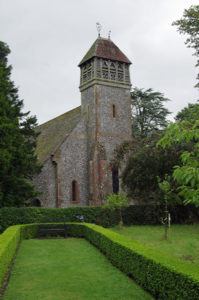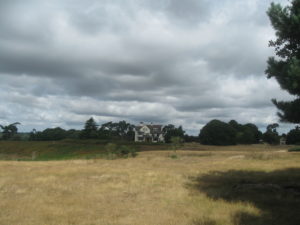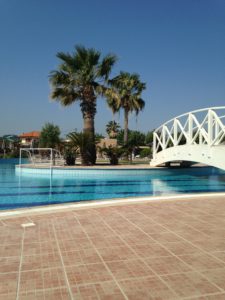Just before the Second World War the phenomenal ship burial at Sutton Hoo was excavated. Almost 80 years later new burials are being discovered, most recently from the generation before the presumed King Raedwald. As well as the site itself, there has been for several years past an exhibition hall, Tranmer House and the inevitable National Trust refreshment centre.
From different parts of the site visitors can look down on Woodbridge, where the ship was moored before being dragged uphill for the burial. There is an argument that the name Woodbridge means a place to cross by boat rather than by bridge to Woden, god of the dead in Valhalla – possibly even suggesting the ancient Greek ferryman who took the dead to Hades. Be that as it may the labour of reaching the hilltop with a heavy ship must have been Herculean.
Today of course we drive in. Reception centre and, needless to say, shop are a few steps from the exhibition hall, opened a few years ago by Seamus Heaney with a reading from his version of the Anglo-Saxon epic “Beowulf”. At its centre is a reconstruction of the burial chamber that closely reflects a scene in the poem. There is a changing display of reproductions of the king’s treasure, now in the British Museum, as well as items recently discovered at Rendlesham, a little way downriver, where it is believed Raedwald had his main hall. More grisly is a “sand body,” one of the victims of a later phase, when the site was used for executions. The body is in fact a resin effigy, like those at Pompeii, because the acid sand at Sutton Hoo quickly dissolves organic matter.
Tranmer House, across the hilltop, is where the landowners lived at the time of the discovery. Today it is a time-capsule, furnished in period style, with a piano that visitors are encouraged to play and numerous other ways of experiencing aspects of wealthy life in the 1930s. This may be just as well for some visitors because after the exhibition hall the burial site is often a bleak experience requiring a good deal of imagination before a well-deserved hot drink back at the centre.
Only guided tours may enter the site, for reasons of conservation, so other visitors take a walk around its circumference. There are tours bookable at Reception. The burials are visible as mounds, from the path or an observation platform that has a map for interpretation. At one point it is possible to pick out the stones covering where a warrior and his horse were buried. There is also the shepherd’s hut that was used during the original excavation.
When we visited there was an art exhibition related to the landscape and burial site. It was a windy day so some of the works were at risk. This is not unusual at Sutton Hoo. I remember when the reception centre was first in operation and two opposing doors were opened simultaneously: the through draught was almost strong enough to have blown cups off tables. Fortunately the art remained intact, and was well worth viewing. Some of it is now available in the Sutton Hoo shop, with more at Snape Maltings a few miles away.
A good place to visit for many reasons, not least healthy exercise, but even in high summer warm clothes may be needed.










